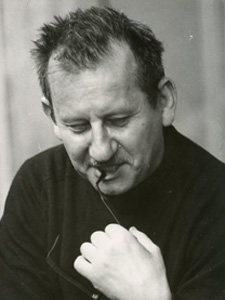Mauricio Lasansky facts for kids
Quick facts for kids
Mauricio Lasansky
|
|
|---|---|
 |
|
| Born |
Mauricio Leib Lasansky
October 12, 1914 |
| Died | April 2, 2012 (aged 97) |
| Nationality | American (b. Argentina) |
| Known for | Printmaking and Drawing |
|
Notable work
|
The Nazi Drawings |
| Movement | American modernism |
| Awards | Five Guggenheim Fellowship (1943, 1944, 1945, 1953, 1964) |
Mauricio Leib Lasansky (born October 12, 1914 – died April 2, 2012) was an important artist and teacher from Argentina. He was famous for his amazing skills in printmaking and for a special series of 33 pencil drawings called "The Nazi Drawings." Lasansky moved to the United States and became a citizen. He started the first Master of Fine Arts program for printmaking in the U.S. at the University of Iowa. Experts like Sotheby's say he was one of the founders of modern printmaking.
Contents
Mauricio Lasansky's Life Story
Mauricio Lasansky was born in Buenos Aires, Argentina, on October 12, 1914. His parents were Jewish immigrants from Eastern Europe. He learned about printmaking and engraving from his Polish father. His father made a living doing these types of art.
Mauricio showed artistic talent from a young age. At 16, he received an honorable mention at an art exhibition. At 17, he won a prize for his sculpture. In 1933, he began studying at the Superior School of Fine Arts in his hometown.
Becoming an Art Director
Three years later, Lasansky started his career as a director. He led the Free Fine Arts School in Villa María, Argentina. He held this job for ten years. During this time, he showed his art in many exhibitions. This led to a big solo show at the Galleria Muller in Buenos Aires in 1943.
Moving to the United States
In 1943, Lasansky moved to New York City. He received his first of five Guggenheim Fellowships. These fellowships are special awards that help artists and scholars. He decided to stay in the United States and become a citizen. This was for political reasons, even though he didn't have much money and struggled with English.
In 1945, he started working at the University of Iowa. He was a visiting lecturer for graphic arts. Within three years, he became a full professor. He then created the school of printmaking there. This school offered the first Master of Fine Arts program in printmaking in the United States. In the 1960s, Time magazine called him "the nation's most influential printmaker." He stayed at the university until he retired in 1984. After retiring, he continued to create art.
Lasansky got married in 1937. He brought his family to the United States in 1944. This was when he received his second Guggenheim Fellowship.
Mauricio Lasansky's Artwork
When Lasansky was in Argentina, he mostly worked with drypoint. He also tried etching, relief etching, and linoleum cuts. He didn't know many other printmakers at the time. This led him to invent new ways to create art using copper plates.
New Techniques and Influences
When he first arrived in the United States, he spent several months studying art. He looked at the huge print collection at the Metropolitan Museum of Art. He also experimented with modern art techniques at Atelier 17 in New York. He learned new intaglio techniques. He was especially influenced by the work of Picasso. Other artists who inspired him included El Greco, Goya, Modigliani, Chagall, and Stanley William Hayter. He was known for making very large metal-plate artworks. Sometimes, he would combine more than 50 plates to make one single image.
The Nazi Drawings
Besides his printmaking, Lasansky is famous for his series called "The Nazi Drawings." He created these 33 drawings between 1961 and 1966. Lasansky said they were inspired by the "unleashing of brutality" during the Holocaust. The Holocaust was a terrible time when many people suffered.
The series was first shown at the Whitney Museum of American Art in 1967. The drawings were made on regular paper using graphite pencil. He also used watercolor washes to suggest blood. The drawings showed the people who were victims and those who caused the terrible events of the Holocaust. But they also showed the bystanders. Lasansky strongly believed that bystanders, who did nothing, also shared some responsibility. As of Lasansky's death in 2012, these important drawings were on display. They were a long-term loan to the University of Iowa Museum.
Awards and Special Recognition
Mauricio Lasansky received many honors and awards throughout his life:
- 1943: Guggenheim Fellowship
- 1944: Guggenheim Fellowship
- 1945: Guggenheim Fellowship
- 1953: Guggenheim Fellowship
- 1959: Honorary Doctorate, Iowa Wesley College
- 1963: Guggenheim Fellowship
- 1969: Honorary Doctorate, Pacific Lutheran University
- 1979: Honorary Doctorate, Carleton College
- 1980: Distinguished Teaching of Art Award, College Art Association
- 1983: Honorary Award in Arts & Humanities, Commission for the Aging
- 1985: Honorary Doctorate, Coe College
- 1990: Academician, National Academy of Arts & Design, New York
- 1999: Iowa Award, 14th Recipient
See also
 In Spanish: Mauricio Lasansky para niños
In Spanish: Mauricio Lasansky para niños

